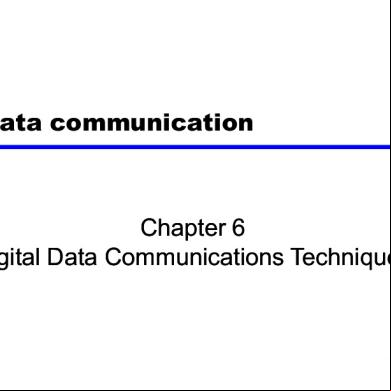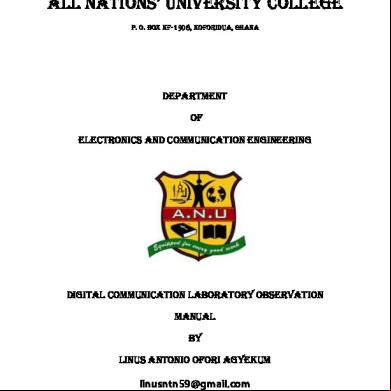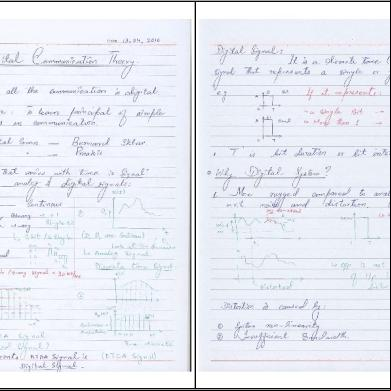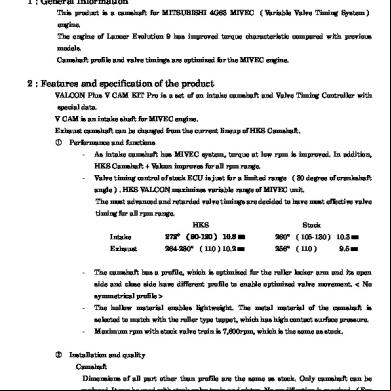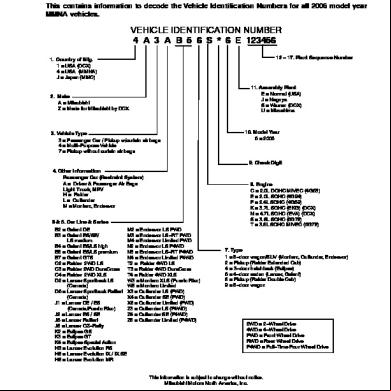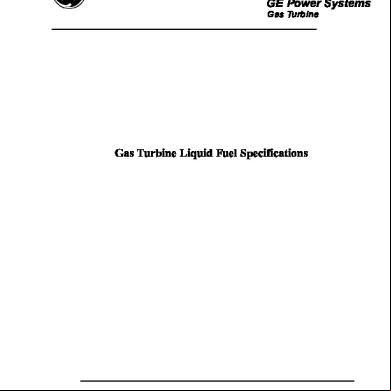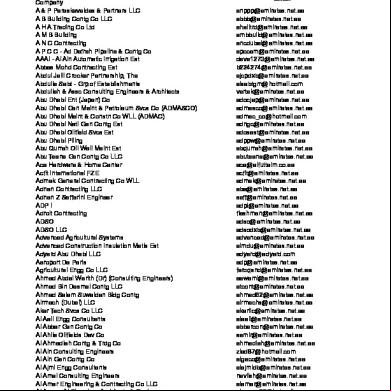Ec302 Digital Communication 3n521
This document was ed by and they confirmed that they have the permission to share it. If you are author or own the copyright of this book, please report to us by using this report form. Report 3b7i
Overview 3e4r5l
& View Ec302 Digital Communication as PDF for free.
More details w3441
- Words: 826
- Pages: 3
COURSE YEAR OF CODE COURSE NAME L-T-P-C INTRODUCTION EC302 Digital Communication 4-0-0-4 2016 Prerequisite: EC204 Signals and Systems, EC208 Analog Communication Course Objectives: To understand the concept of Digital representation of analog source To understand the Performance comparison various pulse modulation schemes To discuss Inter Symbol Interference (ISI) problem in digital communication and to derive the Nyquist Criteria for zero ISI in data Transmission To analyse the need for introducing ISI in controlled manner To understand signal space representation of signal using Gram Schmidt orthonormalisation procedure To analyse the error probability for different modulation schemes like BPSK, BFSK, QPSK etc. To understand the principle of spread spectrum communication and to illustrate the concept of FHSS and DSSS To understand various Multiple Access Techniques Syllabus: Overview of Random variables and Random process, Overall picture and relevance of digital communication, Digital Pulse modulation, Signal space concepts, Matched filter receiver, Review of Gaussian random process, Digital band modulation schemes, Detection of signals in Gaussian noise, Pseudo–noise sequences, Importance of synchronization, Spread spectrum communication, Diversity techniques, Multiple Access Techniques. Expected Outcome The students will be able to i. Illustrate the Digital representation of analog source ii. Compare the performance of various Digital Pulse Modulation Schemes iii. Apply the knowledge of ISI problems in Digital communication to derive Nyquist criteria for zero ISI iv. Analyse the need for introducing ISI in Digital Communication in a controlled manner v. Construct signal space representation of signal using Gram Schmidt orthonormalisation procedure vi. Compare the error probability for different digital modulation schemes like BPSK, BFSK, QPSK etc. vii. Describe the principle of spread spectrum communication and to illustrate the concept of FHSS and DSSS viii. Understand various Diversity Techniques Text Books: 1. John G. Proakis, Masoud Salehi, Digital Communication, McGraw Hill Education Edition, 2014 2. Nishanth N, Digital Communication, Cengage Learning India , 2017 3. Ramakrishna Rao, Digital communication, Tata McGraw Hill Education Pvt. Limited. 4. Simon Haykin, Communication Systems, 4/e Wiley India, 2012.
References: 1. Couch: Analog and Digital Communication. 8e, Pearson Education India, 2013. 2. H.Taub and Schilling Principles of Communication Systems, , TMH, 2007 3. K.Sam Shanmugham, Digital and Analog Communication Systems, John Wiley & Sons 4. Pierre La ,Fundamental Concepts in Communication, Prentice Hall India. 5. Sheldon.M.Ross, “Introduction to Probability Models”, Academic Press, 7th edition. 6. Sklar: Digital Communication, 2E, Pearson Education. 7. T L Singal, Digital Communication, McGraw Hill Education (India) Pvt Ltd, 2015
Module
I
II
III
IV
V
Course Plan Course content
Overview of Random variables and Random process: Random variables–continuous and Discrete, random processStationarity, Autocorrelation and power spectral density, Transmission of Random Process through LTI systems, PSD, AWGN Pulse Code Modulation (PCM): Pulse Modulation, Sampling process, Performance comparison of various sampling techniques Aliasing, Reconstruction, PAM, Quantization, Noise in PCM system Modifications of PCM: Delta modulation, DPCM, ADPCM, , Performance comparison of various pulse modulation schemes, Line codes, PSD of various Line codes Transmission over baseband channel: Matched filter, Inter Symbol Interference (ISI), Nyquist Criteria for zero ISI, Ideal solution, Raised cosine spectrum, Eye Pattern Correlative Level Coding - Duobinary coding, precoding, Modified duobinary coding, Generalized Partial response signalling. FIRST INTERNAL EXAM Signal Space Analysis: Geometric representation of signals, Gram Schmidt orthogonization procedure. Transmission Over AWGN Channel: Conversion of the continuous AWGN channel into a vector channel, Likelihood function, Maximum Likelihood Decoding, Correlation Receiver Digital Modulation Schemes: band transmission model, Coherent Modulation Schemes- BPSK, QPSK, BFSK. NonCoherent orthogonal modulation schemes, Differential Phase Shift Keying (DPSK) Detection of Binary modulation schemes in the presence of noise, BER for BPSK, QPSK, BFSK SECOND INTERNAL EXAM Pseudo–noise sequences: Properties of PN sequences. Generation of PN Sequences, generator polynomials, Maximal length codes and Gold Codes.
End Sem. Hours Exam Marks
3
15 3
4
4 15 3
3 15 4
4 15 5
3
20
VI
Importance of synchronization: Carrier, frame and symbol/chip synchronization techniques. Spread spectrum communication: Direct sequence spread spectrum with coherent binary phase shift keying, Processing gain, Probability of error, Anti-jam Characteristics, Frequency Hop spread spectrum with MFSK, Slow and Fast frequency hopping. Multipath channels: classification, Coherence time, Coherence bandwidth, Statistical characterization of multi path channels, Binary signalling over a Rayleigh fading channel. Diversity techniques: Diversity in time, frequency and space. Multiple Access Techniques: TDMA, FDMA, CDMA and SDMA – RAKE receiver, Introduction to Multicarrier communication- OFDM END SEMESTER EXAM
2
4
3 2
20
5
Question Paper Pattern ( End Semester Exam) Maximum Marks : 100
Time : 3 hours
The question paper shall consist of three parts. Part A covers modules I and II, Part B covers modules III and IV, and Part C covers modules V and VI. Each part has three questions uniformly covering the two modules and each question can have maximum four subdivisions. In each part, any two questions are to be answered. Mark patterns are as per the syllabus with 30% for theory and 70% for logical/numerical problems, derivation and proof.
References: 1. Couch: Analog and Digital Communication. 8e, Pearson Education India, 2013. 2. H.Taub and Schilling Principles of Communication Systems, , TMH, 2007 3. K.Sam Shanmugham, Digital and Analog Communication Systems, John Wiley & Sons 4. Pierre La ,Fundamental Concepts in Communication, Prentice Hall India. 5. Sheldon.M.Ross, “Introduction to Probability Models”, Academic Press, 7th edition. 6. Sklar: Digital Communication, 2E, Pearson Education. 7. T L Singal, Digital Communication, McGraw Hill Education (India) Pvt Ltd, 2015
Module
I
II
III
IV
V
Course Plan Course content
Overview of Random variables and Random process: Random variables–continuous and Discrete, random processStationarity, Autocorrelation and power spectral density, Transmission of Random Process through LTI systems, PSD, AWGN Pulse Code Modulation (PCM): Pulse Modulation, Sampling process, Performance comparison of various sampling techniques Aliasing, Reconstruction, PAM, Quantization, Noise in PCM system Modifications of PCM: Delta modulation, DPCM, ADPCM, , Performance comparison of various pulse modulation schemes, Line codes, PSD of various Line codes Transmission over baseband channel: Matched filter, Inter Symbol Interference (ISI), Nyquist Criteria for zero ISI, Ideal solution, Raised cosine spectrum, Eye Pattern Correlative Level Coding - Duobinary coding, precoding, Modified duobinary coding, Generalized Partial response signalling. FIRST INTERNAL EXAM Signal Space Analysis: Geometric representation of signals, Gram Schmidt orthogonization procedure. Transmission Over AWGN Channel: Conversion of the continuous AWGN channel into a vector channel, Likelihood function, Maximum Likelihood Decoding, Correlation Receiver Digital Modulation Schemes: band transmission model, Coherent Modulation Schemes- BPSK, QPSK, BFSK. NonCoherent orthogonal modulation schemes, Differential Phase Shift Keying (DPSK) Detection of Binary modulation schemes in the presence of noise, BER for BPSK, QPSK, BFSK SECOND INTERNAL EXAM Pseudo–noise sequences: Properties of PN sequences. Generation of PN Sequences, generator polynomials, Maximal length codes and Gold Codes.
End Sem. Hours Exam Marks
3
15 3
4
4 15 3
3 15 4
4 15 5
3
20
VI
Importance of synchronization: Carrier, frame and symbol/chip synchronization techniques. Spread spectrum communication: Direct sequence spread spectrum with coherent binary phase shift keying, Processing gain, Probability of error, Anti-jam Characteristics, Frequency Hop spread spectrum with MFSK, Slow and Fast frequency hopping. Multipath channels: classification, Coherence time, Coherence bandwidth, Statistical characterization of multi path channels, Binary signalling over a Rayleigh fading channel. Diversity techniques: Diversity in time, frequency and space. Multiple Access Techniques: TDMA, FDMA, CDMA and SDMA – RAKE receiver, Introduction to Multicarrier communication- OFDM END SEMESTER EXAM
2
4
3 2
20
5
Question Paper Pattern ( End Semester Exam) Maximum Marks : 100
Time : 3 hours
The question paper shall consist of three parts. Part A covers modules I and II, Part B covers modules III and IV, and Part C covers modules V and VI. Each part has three questions uniformly covering the two modules and each question can have maximum four subdivisions. In each part, any two questions are to be answered. Mark patterns are as per the syllabus with 30% for theory and 70% for logical/numerical problems, derivation and proof.



